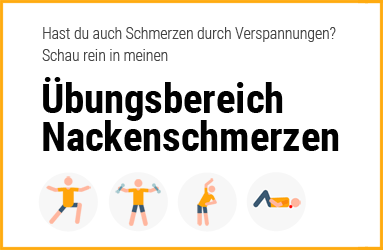The cervical spine is the section of the spine that is the most flexible. In no other section are such twists and inclinations even conceivable.
But only a head resting vertically on the cervical spine promises a painless mobility. An incorrect posture of the head quickly causes tension and cramps in the area of the neck. With a „stiff neck,“ the mobility is so limited that even a slight turning of the head causes great pain.
A poor posture can not only occur during work, but also during leisure activities or unconsciously during sleep .
Tension and hardening of the muscles due to bad posture
Everyday, we take positions far from being optimal for our body . When a malposture is held for too long, the connective tissue become tense and the heavily contracted muscles begin to burn.
If no reaction or action is taken after receiving a warning from the body and the unfavorable posture is maintained or taken again and again, it may sooner or later lead to a shortening of the musculature.

If you are already exercising, then do it the right way! A straight posture relieves the cervical spine and the intervertebral discs.
Moreover, by continuous contractions, the muscles can harden, neck pain will then be the smallest problem. In case of a muscle shortening, the affected muscle is shorter than normal in a resting state and a lower elasticity is present.
In a case of muscle hardening , the capillaries are squeezed inside the muscles, thereby restricting the blood circulation, causing inflammation. The muscles are then stretched automatically to prevent further injury, but prevents a healthy circulation as well.
With massages, acupressure or heat treatments, it is possible to release the tension and thus the neck pain. However, in the long run, the muscle has to learn to relax again.
What is a muscle contraction (muscle shortening)?
The muscle activity consists of contracting (shortening), relaxing as well as stretching muscle fibrils in the muscle fibers. A muscle that can not be stretched to its end point is shortened. The inability to stretch to the maximum can lead to poor posture and even cause inflammation at the corresponding spots.
Bad postures at work and in everyday life
Most of the tension is caused by bad posture at work. For instance, while working on a PC, we tend to rest our arms on the table or our chin in the palm of our hand.
This creates a so-called hunchback.
In this case, cramps occur in the chest and upper neck. At the same time, the back muscles are too weak to pull the shoulders backwards.
When answering a phone call, we clamp the phone between the shoulder and head, to keep hands free for typing. The muscles are then stretched on one side and compressed on the other side.
An arched back, also called a hollow back, arises in an excessive curvature of the lumbar spine. The medically-named hyperlordosis is rarely congenital, but is rather caused by a permanent malposition, especially when standing or sitting. Additionally, different sports can cause tension and thus neck pain. When swimming, the head of many people is placed too far back in the neck to get enough air and to avoid water in the eyes.
Wrong sitting posture causes pain
Anyone sitting in the office or at home risks creating damage to the spine and tension causing pain in the neck, back, shoulders and head.
Anyone sitting straight and aware of their posture relaxes the muscles thus providing tension. The ideal equipment for a workplace is the adjustable standing desk, which provides the opportunity to repeatedly switch from sitting to standing. As a result, the spine is relieved and the muscles are preserved from painful hardening.
Wrong walking strains the spine
A lot can be done wrongly while walking. A bent-over position strains the neck and the entire spine.

Correct standing posture should be learned in order to burden the spine as little as possible.
Tension can also occur when carrying heavy items. Frequently, the neck is then retracted for greater stability. Even at night during sleep, poor posture can occur. Usually the matress is either too hard or too soft. If we sink in too deep, the muscles can cramp. If the mattress is too hard, the muscles will not come to rest. In both cases, tensions and neck pain are the result.
Conclusion
If we have an activity that is mostly performed seated, the employer should invest in a special office chair. Although these are very expensive, they help to avoid – or at least minimize – malposition. In general, relaxation and body care should always be taken after a long unfavorable posture. Sometimes, light stretching exercises are enough to protect us from neck pain.
„Wer sich kaum bewegt und noch dazu acht Stunden täglich vor einem Bildschirm kauert, macht dem Rücken keine Freude.“





 „Wer sich kaum bewegt und noch dazu acht Stunden täglich vor einem Bildschirm kauert, macht dem Rücken keine Freude.“
„Wer sich kaum bewegt und noch dazu acht Stunden täglich vor einem Bildschirm kauert, macht dem Rücken keine Freude.“